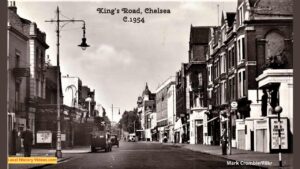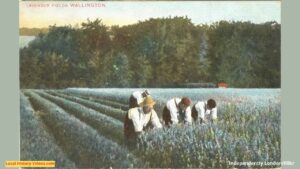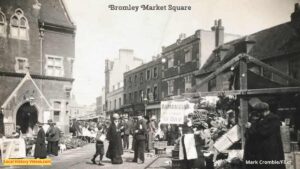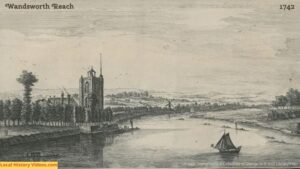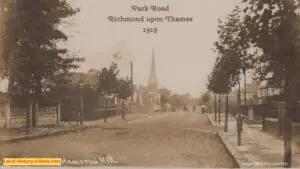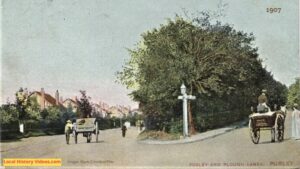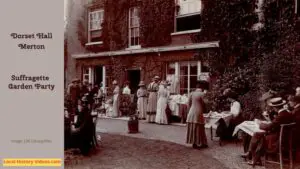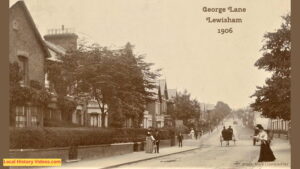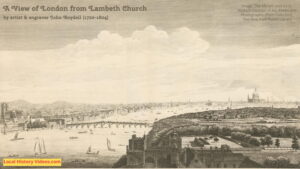Glimpse history through old images of Kensington, London, England, UK.
Kensington Wedding 1938
When Lady Mabel Fox Strangways arrived at St. Mary Abbotts church for her marriage to the Honourable Ivor Grosvenor Guest, 2nd Viscount Wimborne, the streets outside were crowded with local people who had come to witness the happy couple.
But they were left disappointed, as she was secretly driven to the side door of the church, from which the newly married couple later emerged, unobserved except for a select few. And the bride looked distinctly unhappy both times.
On the upside, the newsreel cameraman filmed the large gathering, so we have both the people and the nearby buildings on film.
English composer William Walton composed “Set me as a seal upon thine heart” for their wedding.
Kensington Wedding (1938) – British Pathé on YouTube
Mechanical Toys 1952
Mrs Eveline Butler repaired mechanical toys in her antiques shop in Kensington.
Mechanical Toys (1952) – British Pathé on YouTube
Circus Performer 1967
If you can cope with the terrifying antics of aerialist and trapeze artist Sebastian as he practices his moves on a steel bar over the side of a tall office block, with no safety equipment whatsoever, you’ll see some great shots across the nearby streets.
Kensington High (1967)- British Pathé on YouTube
Ruston Close 1971
Unfortunately the sound is missing from this footage, but it’s a fascinating look at the Victorian terrace demolished in Ruston Close in 1971.
The workmen even used one of the derelict homes as the site for a fire, into which debris was thrown.
There’s minimal safety for the workers as they demolish large and sturdy buildings with nothing but a pickaxe.
Demolition Workers – Kensington (1971) – British Pathé on YouTube
Historic Book
Extract from “History and Antiquities of Kensington” by William Faulkner
Published 1820
Pages 287-292
KENSINGTON consists principally of one street , which extends about
three quarters of a mile in length , from the Goar to Earl’s Terrace .
The town being in the direct road for the Western parts of England ,
is in a constant bustle , and resembles the most populous streets in
London , especially in an evening , when the mails are setting out on their
various destinations .
Bowack thus describes it in the year 1705 –
This town standing in a wholesome air , not above three miles from
London , has ever been resorted to by persons of quality and citizens ,
and for many years past honoured with several fine seats belonging to
the Earls of Nottingham , and Warwick . We cannot indeed find it was .
ever taken notice of in history , except for the great Western Road
through it , nor hath any thing occurred in it , that might perpetuate its
name , till his late Majesty King William was pleased to ennoble it
with his court and royal presence . Since which time it has flourished
even almost beyond belief ; and is inhabited by gentry and persons
of note : there is also abundance of shop – keepers , and all sorts of
artificers in it , which makes it appear rather like part of London , than
a country village .
It is , with its dependencies , about three times as big as Chelsea , in
number of houses , and in summer time extremely filled with lodgers ,
for the pleasure of the air , walks , and gardens round it , to the great
advantage of its inhabitants .
The buildings are chiefly of brick , regular , and built into streets ;
the largest is that through which the road lies , reclining from the
Queen’s House , a considerable way beyond the Church . From the
Church runs a row of buildings towards the north , called Church Lane ,
but the most beautiful part of it is the Square , south of the road ; which
for beauty of buildings , and worthy inhabitants , exceed several noted
squares in London . “
The first house west of Gloucester Road , on the south side of the
great Western Road , on entering from the Gore , is called
NOEL HOUSE , Kensington Gore . – This mansion was built in the
year 1804 , from a design of the late Mr. Byfield .
It consists of three rooms on the two principal floors ; an entrance
hall , with open galleries , on the first and second floors ; and a great
stair case , extending to the first floor , and balconies to both north
and south fronts . The whole premises comprise near four acres . The
pleasure ground is tastefully disposed , and was planted under the in
spection of the late Mrs. Murray Aust ” .
The drawing rooms of the south front , command charming views of
the Surry hills , and the surrounding country , and the situation of the
house , viewed from the mount in the gardens , is quite picturesque , as it
appears to be embosomed in the woods of Kensington gardens , including
a prospect of the Lodge at the west end of Hyde Park , of which it
seems to form a connected part .
It is the property of G. Aust , esq . , . who resides here with his family ,
and it takes its name from the late owner of the ground , Sir Gerard
Noel , bart . , being part of the ancient domain of the Earls of
Gainsborough .
The Nursery of Messrs . Malcolm and Co. adjoins the preceding
premises on the west , fronting the road . The large new house , at the
corner of Love Lane , built in the cottage style , is the residence of
Samuel Drewe , esq .
A large house , now called Kensington House , built about the time
of King William , was the property of the Noel family ; some of whom
probably resided in it . It was taken by Mr. Elphinstone in 1776 for a
school , and occupied by him till 1788 .
This gentleman , whose death has been already mentioned , was
ludicrously characterised in Smollett’s Roderick Random , which , in
consequence became a forbidden book in his school .
COLBY HOUSE is the residence of W. Mair , esq . , one of his Majesty’s
Justices of the Peace , and a Deputy Lieutenant for the County of
Middlesex . 1
This capital mansion , situated facing the palace gates , was built
about 1720 , by Sir Thomas Colby , bart . , whose family resided many
years in this parish .
The house consists of a centre and two wings , and is two stories in
height….
Sir Thomas Colby , the former proprietor of this house , who built it ,
and resided in it many years , was created a baronet in 1720 , and
described of Kensington . Dr. King relates the following anecdote of
this gentleman :
” I knew one Sir Thomas Colby , who lived at Kensington , and was ,
I think , a commissioner in the victualling office : he killed himself by
rising in the middle of the night , when he was in a very profuse sweat ,
the effect of a medicine which he had taken for that purpose , and
walking down stairs to look for the key of the cellar , which he had
inadvertently left on a table in his parlour : he was apprehensive that
his servants might seize the key and rob him of a bottle of Port wine .
This man died intestate , and left more than 200,000 / . in the
funds , which was shared among five or six day labourers , who were
his nearest relations . ” He was a benefactor to this parish , and was
buried in the church .
The house now inhabited by Mr. Bird was formerly the Red Lion
inn and the principal inn in the town , it was much used by travellers
on the Western road : the premises were extensive .
The Manor Courts were once held at the house at the eastern corner
of Young Street .
Mr. Young was an eminent builder in this town on the time of James
II . and King William : he built the street called after his name , and a
great part of the Square .
THE SQUARE Occupies an area of about two hundred and fifty
feet : it was begun to be built in the reign of James II . , and was finished
about 1698 , as appeared by a stone lately to be seen against the
north – east corner .
While the Court was held at Kensington most of the houses were
inhabited by persons of quality , ambassadors , gentry , and clergy , and
at one time upwards of forty carriages were kept in and about the
neighbourhood . In the time of George the Second the demand for
lodgings was so great that an ambassador , a bishop , and a physician have
been known to occupy apartments in the same house . But the late
King never having resided at Kensington , the Square became deserted ,
until the act was obtained for lighting and paving it , since which
period some of the houses have been wholly , and others in part ,
rebuilt , and it is now very respectably inhabited .
The following eminent persons appear , from the parish books , to have
resided here at various periods :
The Duchess of Mazarine in 1692 .
Sir Robert Hamilton in 1693 .
The Earl of Gainsborough in 1697 .
And subsequently , Dr. Mathias Mawson , Bishop of Ely , occupied ,
for several years , the house at the south west corner…”
Page 315
“From Rhodes’s map of Kensington , published in the early part of the
last reign , it appears there was a cold bath at the west end of Parson’s
Yard , which by tradition , was much resorted to . The sites of Hornton
Street and Phillimore Place , are laid down in the same map , as inclosed
fields , with a solitary house standing by the side of the great
Western Road.”
More Pictures of Old Kensington
Old Kensington in London, England, enjoyed through vintage photos, historic pictures & archive film. Browse history in these fascinating old images of a bygone era on my Pinterest board at:
https://www.pinterest.co.uk/LocalHistoryVideos/kensington-old-photos-pictures
More about Greater London
- Chelsea, London: History in Old ImagesEnjoy a glimpse of history through old images of Chelsea in Greater London, England, UK.
- Wallington, London: History in Old ImagesEnjoy a glimpse of history through old images of Wallington, in Greater London, England, UK.
- Bromley, London: History in Old ImagesEnjoy a glimpse of history through old images of Bromley, in London, England, UK.
- Old Images of Wandsworth, LondonGlimpse history through old images of Wandsworth, London, England, UK.
- Old Images of Southwark, LondonGlimpse history through old images of Southwark, London, England.
- Old Images of Richmond upon Thames, LondonGlimpse history through old images of Richmond upon Thames, London, England, UK.
- Old Images of Purley, LondonGlimpse history through old images of Purley, London, England, UK.
- Old Images of Merton, LondonGlimpse history through old images of Merton, London.
- Old Images of Lewisham, Southeast LondonGlimpse history through old images of Lewisham, in Southeast London, England.
- Old Images of Lambeth, LondonEnjoy a glimpse of history through old images of Lambeth, London, England.


